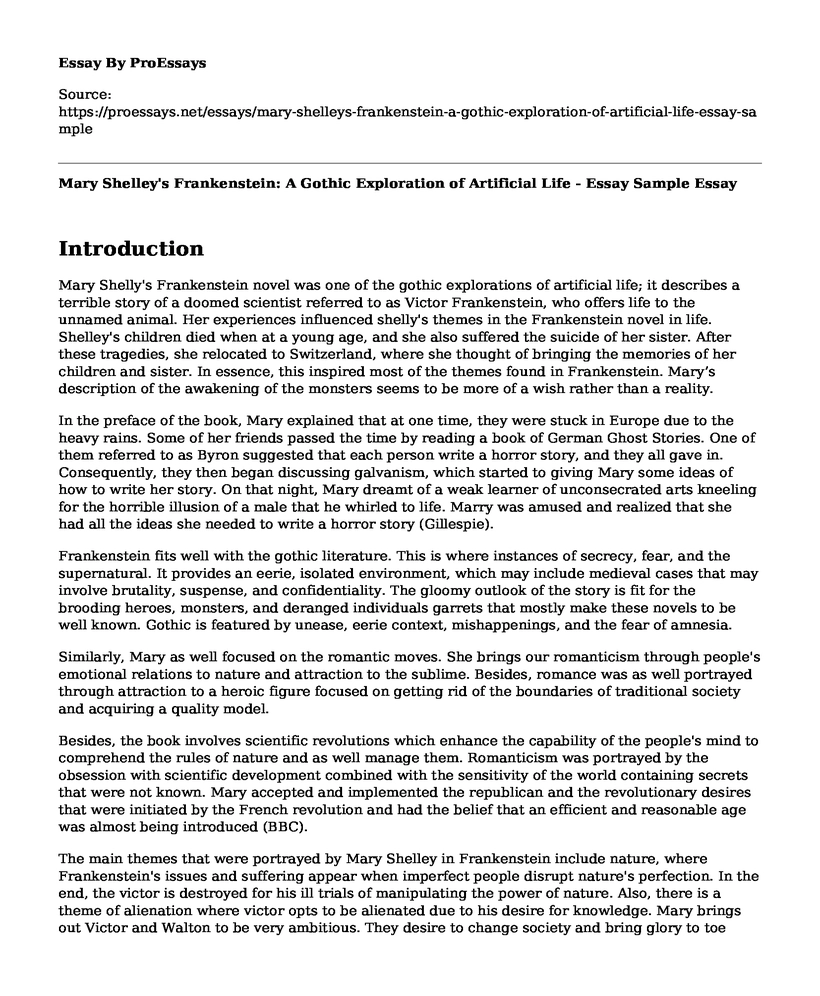Introduction
Mary Shelly's Frankenstein novel was one of the gothic explorations of artificial life; it describes a terrible story of a doomed scientist referred to as Victor Frankenstein, who offers life to the unnamed animal. Her experiences influenced shelly's themes in the Frankenstein novel in life. Shelley's children died when at a young age, and she also suffered the suicide of her sister. After these tragedies, she relocated to Switzerland, where she thought of bringing the memories of her children and sister. In essence, this inspired most of the themes found in Frankenstein. Mary’s description of the awakening of the monsters seems to be more of a wish rather than a reality.
In the preface of the book, Mary explained that at one time, they were stuck in Europe due to the heavy rains. Some of her friends passed the time by reading a book of German Ghost Stories. One of them referred to as Byron suggested that each person write a horror story, and they all gave in. Consequently, they then began discussing galvanism, which started to giving Mary some ideas of how to write her story. On that night, Mary dreamt of a weak learner of unconsecrated arts kneeling for the horrible illusion of a male that he whirled to life. Marry was amused and realized that she had all the ideas she needed to write a horror story (Gillespie).
Frankenstein fits well with the gothic literature. This is where instances of secrecy, fear, and the supernatural. It provides an eerie, isolated environment, which may include medieval cases that may involve brutality, suspense, and confidentiality. The gloomy outlook of the story is fit for the brooding heroes, monsters, and deranged individuals garrets that mostly make these novels to be well known. Gothic is featured by unease, eerie context, mishappenings, and the fear of amnesia.
Similarly, Mary as well focused on the romantic moves. She brings our romanticism through people's emotional relations to nature and attraction to the sublime. Besides, romance was as well portrayed through attraction to a heroic figure focused on getting rid of the boundaries of traditional society and acquiring a quality model.
Besides, the book involves scientific revolutions which enhance the capability of the people's mind to comprehend the rules of nature and as well manage them. Romanticism was portrayed by the obsession with scientific development combined with the sensitivity of the world containing secrets that were not known. Mary accepted and implemented the republican and the revolutionary desires that were initiated by the French revolution and had the belief that an efficient and reasonable age was almost being introduced (BBC).
The main themes that were portrayed by Mary Shelley in Frankenstein include nature, where Frankenstein's issues and suffering appear when imperfect people disrupt nature's perfection. In the end, the victor is destroyed for his ill trials of manipulating the power of nature. Also, there is a theme of alienation where victor opts to be alienated due to his desire for knowledge. Mary brings out Victor and Walton to be very ambitious. They desire to change society and bring glory to toe themselves by using their scientific accomplishments. Nevertheless, their efforts are significantly flawed and lead to misfortune for all people (Shelley).
Mary brings out birth as both creative and destructive. The created monster becomes a distorted reflection of the normal cycle of life; thus, it takes over the corrupt nature of Frankenstein in his desire for glory. He pours a torment of light onto the dark world. Though he attains something awe-inspiring, he plays with fire at his own ethical expense. This is imagery that contrasts light and dark. These occurrences suggest the spark o the fire as well as the power of radical ideas to bring out darker parts of life.
Works Cited
BBC. ‘Frankenstein’ Bitesize. www.bbc.co.uk/bitesize/guides/z2s3j6f/revision/3Gillespie, Iseult. 'Everything you need to know to Read.' Youtube, 23, February 2017, www.youtube.com/watch?v=PDgu25Dsv34&feature=youtu.be
Shelley Mary. 'Frankenstein.' Dover Thrift editions, 1994
Cite this page
Mary Shelley's Frankenstein: A Gothic Exploration of Artificial Life - Essay Sample. (2023, Aug 01). Retrieved from https://proessays.net/essays/mary-shelleys-frankenstein-a-gothic-exploration-of-artificial-life-essay-sample
If you are the original author of this essay and no longer wish to have it published on the ProEssays website, please click below to request its removal:
- Paper Example on Time in Shakespeare's Sonnets and Plays
- The Theme of Silence in Woman Warrior - Critical Essay
- Essay Sample on George Orwell's Position on Imperialism
- Major Attributes of the Portrayal of Nature in Wordsworth's Poetry Essay
- Lady Macbeth: Power & Insecurity in Over-Ambition - Essay Sample
- Paper Example on Fantasy & Illusion: Tennessee Williams' 'The Streetcar Desire'
- Analytical Essay Sample on the Importance of Reading for a Writer







